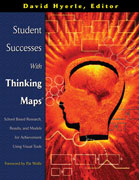



 dent Successes With Thinking Maps®
dent Successes With Thinking Maps®David Hyerle, editor with Sarah Curtis and Larry Alper co-editors
Chapter 16: Inviting Explicit Thinking
Sarah Curtis, M.Ed.
“I was teaching a lesson in social studies and I must have asked a question every conceivable way I could think of. Nobody participated. So I drew a Multi-flow Map on the board and got where I wanted to go! Thinking Maps not only seized the teachable moment, they created the teachable moment.”
Teacher
Ultimately, I came to see that these deeper levels of reflection and performance changes developed because the thinking maps invite explicit thinking and thus reflection, bringing a clarity that inspires confidence and competence.
My study focused on those teachers who participated in the Thinking Maps Training of Trainers professional development sessions. Although I was primarily interested in how teachers created thinking maps for the purpose of engaging in reflection about learning and instruction aside from their daily classroom interactions with students, I also found that teachers used students’ thinking maps examples and teacher generated thinking maps lesson plans as visual references that generated reflection about student learning, instruction, and planning. Teacher reported data revealed positive changes in both student behavior and performance and teacher curriculum and instruction as a result of thinking maps implementation.
At the third Training of Trainers session, a kindergarten teacher couldn’t wait to share what she had learned with the group. In preparation for a lesson comparing and contrasting two books about George Washington, she had drawn a double bubble map with four bubbles for the similarities and three bubbles on each side for the differences. During the lesson, she recorded the children’s responses, but within moments, they had exhausted her template. “You need more bubbles!” they chorused. Their powers of observation and attention to detail astounded her. She learned how attentive her students were and planned to use those responses as a rubric by which to judge their future work. The map was an unexpected assessment tool. Moreover, her students reminded her not to predetermine their capacity for information. “My thinking could have limited their thinking!” Reflecting about this experience led her to question her expectations of her students and their proficiency with observation and comprehension skills.
Read the complete chapter in the book Student Successes With Thinking Maps. Key sections from the chapter Inviting Explicit Thinking with excerpts above include:
- Responsibile and Responsive Professional Development
- Thinking Maps: a Model for Reflective Practice
- Results of Teacher-Reported Reflections
- Reflections on Student Learning and Behavior
- Teacher Instruction and Planning
- Beyond the Classroom
- Creating a Culture of Change Inviting Explicit Thinking
Sarah Curtis, M.Ed.
 Sarah is a former elementary school teacher who used Thinking Maps in her classrooms for over seven years. As a classroom teacher she was featured in the Video Journal series Visual Tools: From Graphic Organizers to Thinking Maps. She is now Director of Consulting for DFT and is one of a select group of nationally certified Trainer of Trainers for both Thinking Maps and Write From the Beginning. Sarah is also the author/editor of the new Mapping the Standards CD, a database of Thinking Maps activities correlated to the national and state standards and activated by Thinking Maps Software.
Sarah is a former elementary school teacher who used Thinking Maps in her classrooms for over seven years. As a classroom teacher she was featured in the Video Journal series Visual Tools: From Graphic Organizers to Thinking Maps. She is now Director of Consulting for DFT and is one of a select group of nationally certified Trainer of Trainers for both Thinking Maps and Write From the Beginning. Sarah is also the author/editor of the new Mapping the Standards CD, a database of Thinking Maps activities correlated to the national and state standards and activated by Thinking Maps Software.
Contact Sarah at teachcurtis@aol.com
![]() Click here (pdf file) to download Research Highlights from
Click here (pdf file) to download Research Highlights from
Student Successes With Thinking Maps
For more on Student Successes With Thinking Maps go to the following links: